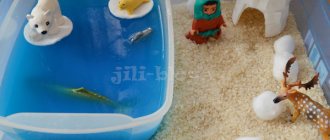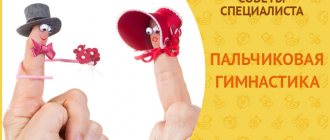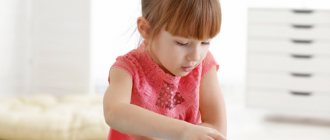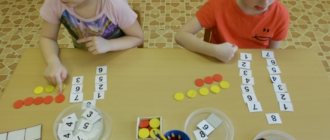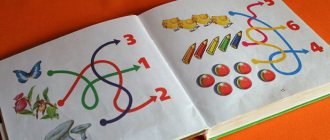Fun activities for children aged 2-5 years. Music classes
By nature, every child is musical. It is difficult to imagine a more favorable period for the development of musical abilities than childhood.
Musical and didactic games help develop the ability to listen to music, distinguish pitch, timbre, dynamics and duration of sound, develop independent musical activity, and help consolidate children’s knowledge of musical instruments.
Children's music playing expands the scope of a child's musical activity, increases interest in musical activities, promotes the development of musical memory and attention, helps overcome stiffness and shyness, and expands musical education.
During the game, children display the individual characteristics of the performer: the presence of will, emotionality, concentration, creative and musical abilities develop and improve.
Loudly - quietly binge drinking
Game material
Any toy.
Progress of the lesson
Several people can take part in the game. They can be the baby's relatives or his friends.
A driver is selected and leaves the room. The rest agree on where to hide the toy.
The driver’s task is to find it, guided by the sound of the song, which can be sung by all participants or one of the players. Everyone needs to remember the basic rule: the sound of the song increases as you approach the place where the toy is located, or weakens as you move away from it.
If the child has completed the task, then another driver is selected, and this child hides the toy when the game is repeated.
Noise and rustle
(Development by S. S. Klimova)
Game material
Rustling objects (you can choose any that you have at home), for example:
— fabric rattles with crunchy and rustling elements sewn in;
- paper;
- rain stick;
- plastic bag
Progress of the lesson
You can do it in silence, or with music, for example, “Noise and Rustle” by E. Poplyanova.
Place all items under the material (hidden from the child).
The child is sitting nearby. An adult takes turns taking out objects and showing how this or that object rustles. After your show, you should definitely give it to the child so that he can play and rustle.
Then the song starts. During the song, the child rustles with one object at first, with a second object when turned on again, etc. When last turned on by all items.
Fairy tale Teremok with musical and/or noise instruments
Game material
Each character in a fairy tale needs an instrument or rattle to voice it. Below is an example of what musical and noise instruments you can use, but you can use absolutely anything you have on hand.
Example of tools:
- mouse-norushka - any bath toy that squeaks or a metallophone in the upper case;
- frog-croak - castanets or wooden spoons or wooden frog - guiro;
- runaway bunny - maracas or shakers;
- little fox-sister - medium register metallophone or xylophone;
- top-gray barrel - tambourine or tambourine;
- clubfoot bear - drum.
You can also use a rain stick - for example, adding that it is raining or a pan flute, a harmonica - the wind, etc. It all depends on your imagination.
Fairy tale
There is a tower in a field. A small mouse runs past. She saw the tower, stopped and asked:
- Terem-teremok! Who lives in the mansion? (the child plays the instrument, pretends to be a mouse).
Nobody responds. The mouse entered the little mansion and began to live there.
A frog-frog galloped up to the mansion and asked:
- Terem-teremok! Who lives in the mansion? (the child plays the instrument, pretends to be a frog).
- I, little mouse! And who are you? (the child plays the instrument, pretends to be a mouse).
- And I am a frog-croak (the child plays the instrument, imitates a frog).
- Come live with me! The frog jumped into the tower. The two of them began to live together.
A runaway bunny runs past. He stopped and asked:
- Terem-teremok! Who lives in the mansion? (child plays an instrument, pretends to be a hare)
- I, little mouse! (child plays an instrument, pretends to be a mouse)
- I, frog-frog! And who are you? (child plays an instrument, pretends to be a frog)
— And I’m a running bunny (the child plays the instrument, pretends to be a hare)
- Come live with us! The hare hops into the tower! The three of them began to live together.
A little fox-sister walks by. She knocked on the window and asked:
- Terem-teremok! Who lives in the mansion? (child plays an instrument, pretends to be a fox)
- I, little mouse (the child plays the instrument, pretends to be a mouse)
— I, the frog-croak (the child plays the instrument, pretends to be a frog)
- Me, the runaway bunny. And who are you? (child plays an instrument, pretends to be a hare)
- And I am a little fox-sister (the child plays the instrument, pretends to be a fox)
- Come live with us! The fox climbed into the mansion. The four of them began to live together.
A gray barrel top came running, looked in the door and asked:
- Terem-teremok! Who lives in the mansion? (child plays an instrument, pretends to be a wolf)
- I, little mouse (the child plays the instrument, pretends to be a mouse)
— I, the frog-croak (the child plays the instrument, pretends to be a frog)
— I, the running bunny (the child plays the instrument, pretends to be a hare)
- Me, little fox-sister. And who are you? (child plays an instrument, pretends to be a fox)
- And I am a top-gray barrel (the child plays the instrument, pretends to be a wolf)
- Come live with us!
The wolf climbed into the mansion. The five of them began to live together. Here they live in a little house, sing songs.
Suddenly a clubfoot bear walks by. The bear saw the tower, heard the songs, stopped and roared at the top of his lungs:
- Terem-teremok! Who lives in the mansion? (child plays an instrument, pretends to be a bear)
- I, little mouse (the child plays the instrument, pretends to be a mouse)
— I, the frog-croak (the child plays the instrument, pretends to be a frog)
— I, the running bunny (the child plays the instrument, pretends to be a hare)
— I, little fox-sister (the child plays the instrument, pretends to be a fox)
- I, the top-gray barrel. And who are you? (child plays an instrument, pretends to be a wolf)
- And I’m a clubfooted bear (the child plays the instrument, pretends to be a bear)
- Come live with us!
The bear climbed into the tower. He climbed and climbed and climbed and climbed - he just couldn’t get in and said:
- I’d rather live on your roof (child plays an instrument, pretends to be a bear)
The bear climbed onto the roof and just sat down, the tower crackled and fell apart.
We barely managed to jump out of it:
- little mouse (the child plays the instrument, pretends to be a mouse),
— frog-croak (the child plays the instrument, pretends to be a frog),
— runaway bunny (the child plays the instrument, pretends to be a hare),
— little fox-sister (the child plays the instrument, pretends to be a fox),
— a top-gray barrel (the child plays the instrument, pretends to be a wolf)
- everyone is safe and sound.
They began to carry logs, saw boards, and build a new mansion.
They built it better than before!
How to tell about notes?
Before you introduce your child to notes, you need to explain to him what they are.
Notes are recorded sounds. Just as we write our speech in letters, so music is written in notes. There are a huge variety of notes: both high and low, but they are all divided into 7 basic ones, which everyone knows: do, re, mi, fa, salt, la, si.
The notes live on a musical staff, which consists of 5 lines. The notes can be located either directly on these lines, or between them, they can also be under and above the lines, and on additional lines that we draw above or below.
Draw a staff of music on a large sheet of paper and write notes in a row on it (you can color them in different colors). Then sing them all together with your child.
To make your child interested in learning notes, you can show him a cartoon about the notes “Do Re Mi.”
A start has been made - the child has a general understanding of notes. Only after showing interest in notes can you start learning them seriously (it’s better to do this on another day).
What is rhythm
Rhythmics is the performance of simple dance movements to music. Rhythmic classes are considered the child’s first conscious steps in dancing. Children become familiar with such concepts as “fast” and “slow”, “loud” and “quiet”, “fun” and “sad”, and learn to move to musical accompaniment. Unlike other musical and physical activities, rhythmics does not focus on technique or physical development of the child. The main emphasis is on the development of coordination, the ability to hear music and perceive rhythm (alternating sounds and pauses).
When planning rhythm classes, it is important to take into account the age characteristics of children.
Children 3-4 years old have poorly developed coordination, they have poor body control and do not understand how to connect their movements with music. The main task of the music director is to help the child develop coordination of movements.
By the age of five, a child can already coordinate not only his own actions, but also work in pairs. He has a good imagination and can repeat a combination of several movements at a time.
At the age of 7, the child already has full control of his body. He can express emotions and feelings through movements, control the quality of performance, and come up with his own movements and combinations.
It is important for the teacher to select exercises for classes in such a way that they correspond to the age of the students.
A selection of rhythmic exercises for children 3-4 years old
Select exercises for rhythmic classes in such a way that children enjoy doing them and at the same time receive tangible benefits - they develop coordination of movements and a sense of rhythm.
Rhythmic echo
Goal: to teach children to hear the rhythm of music.
Children stand in a circle. A short excerpt of a simple piece of music begins to sound, for example, “Chickens” or “Two Cheerful Geese.” The children's task is to exactly repeat the rhythm of the music by clapping their hands. If children have mastered a simple melody, you can increase the duration of the musical segment.
Faster-slower
Goal: to teach children to respond to the rhythm of music and quickly switch from one rhythm to another, to develop attention and improve walking and running skills.
Children stand in a circle and begin to step one after another with their left foot to the beat of the music. As soon as the melody speeds up, the children start running. During the exercise, you can change the speed of the songs several times. For musical accompaniment, we recommend using the melodies “Polka” and “About the Siskin”.
Soldier's March
Goal: to develop a sense of tact in children.
Children stand in a line one after another and choose a “commander”. The teacher plays the song “Soldier's March”. The children’s task is to sit down and stand up for each new musical phrase, and bend over and stand up for the next phrase. And so several times in a row.
Freeze
Goal: to teach a child to express his feelings and emotions through dance.
Children move freely around the hall to the music and dance freely. As soon as the music stops, they should freeze in place in the position they were in. The teacher talks to the kids about why they stopped in this particular position and what it means from an emotional point of view. Then another melody starts playing and the exercise is repeated.
The wind blows
Goal: relax after the active part of the lesson and restore breathing.
Children stand in a circle, the teacher turns on a slow lullaby and says: “We will blow far, we will blow close.”
When hearing the words “we will blow far away,” the children begin to blow very, very hard, but when they say “we will blow close,” on the contrary, they begin to blow weakly and weakly. And so on several times.
Follow the described recommendations when building rhythm classes, and the children will happily run to each lesson. In the next article you will learn about rhythmic exercises for children 5-7 years old.
What sounds of nature should I include for my child to listen to?
- Sounds of the rain;
- Storm;
- Surf;
- Sounds of the forest;
- Birdsong;
- Animal voices;
- Sounds of the city.
Musical development is the ability to distinguish and understand different sounds surrounding a child, the ability to feel the beauty of the surrounding world. In addition to classical works and children's songs, sometimes include sounds from different parts of the world and natural phenomena. While listening to a certain sound, explain what the baby hears and who or what makes that sound.
